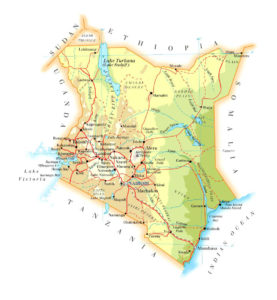
We work in Western Kenya, one of the poorest areas of Kenya (Wikipedia link), mainly in the Counties of Kakamega and Vihiga, which are located on the fringes of the Rift Valley in the Lake Victoria basin. The climate is equatorial with a bimodal pattern of rainfall with mean precipitation of about 1900 mm, which peaks in April to June for long rains, and in November and December for short rains. Weather patterns, however, have become erratic and unpredictable, with extreme weather conditions often resulting in food insecurity even after harvest. 80% of the population depends on agriculture, farming their (mostly too) small plots of land, which are rainfed only. Close to 50% of the population lives below the national poverty line. Main economic activities include tea, maize, sorghum and dairy farming. High population has led to a serious fragmentation of the land into uneconomical units and great environmental degradation, including depleted soils and soil erosion.
Only about 20% of the population in the rural areas has access to safe water for drinking. This condition is exacerbated by low health standards and poor sanitation.

